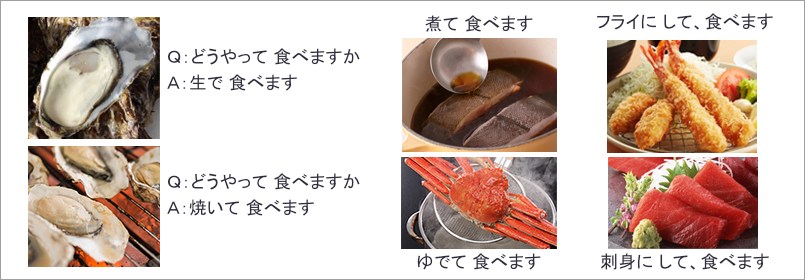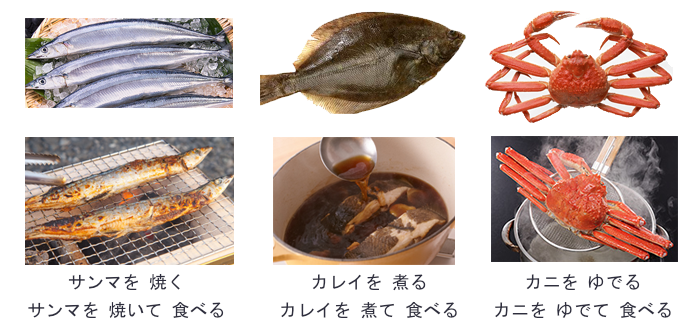
みなさんの 国では どうやって カキを 食べますか。
生で 食べますか、焼いて 食べますか。
日本では カキを フライに して、食べます。
日本 料理で「魚」と 言えば、刺身です。
日本人は 魚や 貝を 生で 食べます。
でも、生 ばかり 食べて いる わけじゃないです。
魚や 貝を 焼いて 食べたり、煮て 食べたり、します。
私は サンマを 焼いて 食べます。
私は カレイを 煮て 食べます。

カニは 刺身に して 食べたり、ゆでて 食べたり、します。
私は 刺身より ゆでた 方が 好きです。
ですから、私は カニを ゆでて 食べます。
食べ方は 国に よって 違う し、人に よって 違います。
Practice Each Sentence
 |
1. |
|
みなさん everyone, you, くに country, -で place marker; in, at
どうやって たべますか?how do you eat it?
どうやって how, かき/カキ oyster, tabemasu to eat
 |
2. |
|
なまで たべます eat something raw
なま raw, uncooked, -で means or method marker; by, with, in
やいて te form of yakimasu; grill, broil, roast, bake, toast
-か or, -か? question marker
[noun A desu] ka, [noun B desu] ka?
[verb A-masu] ka, [verb B-masu] ka?
 |
3. |
|
にほんで in Japan, -で place marker; in, at, かき/カキ oyster
フライ deep-fry, deep-fried food, -に します make A to B, change A to B
 |
4. |
|
りょうり [sv] cooking, food, dish, cuisine, -で indicating a situation, scene, event, issue, field, etc.
さかな fish, -と いえば speaking of, when it comes to, -と quotation marker; ".....", that
いえば ba conditional form of iimasu; if one says, さしみ sliced raw fish
日19,本51,料181,理182,魚172,言121,刺1051,身882
 |
5. |
|
さかな fish, かい shellfish, -や A, B, etc
なま raw, uncooked, -で means or method marker; by, with, in, たべます to eat
日19,本51,人46,魚172,貝1246,生266,食116
 |
6. |
|
なま raw, uncooked, -ばかり (noun +) only, all
たべて te form of tabemasu; eat, -て いる expressing progressive, state or habitual action
-わけじゃない it doesn't mean that
 |
7. |
|
さかな fish, かい shellfish, -や A, B, etc
やいて te form of yakimasu; grill, broil, roast, bake, toast
にて te form of nimasu; to boil (with soy sauce, etc.)
たべた ta form of tabemasu, -たり、-たり、します do this and that (and so on)
 |
8. |
|
さんま/サンマ Pacific saury, やいて te form of yakimasu / yaku; grill, broil, roast, bake, toast
 |
9. |
|
かれい/カレイ Pleuronectidae, flatfish, にて te form of nimasu / niru; to boil (with soy sauce, etc.)
 |
10. |
|
かに/カニ crab, さしみ sliced raw fish
-に します make A to B, change A to B, して te form of shimasu
ゆでて te form of yudemasu / yuderu; boil (without sauce)
-たり、-たり、します do this and that (and so on)
 |
11. |
|
さしみ sliced raw fish, ゆでた ta form of yudemasu / yuderu; boil (without sauce)
[A]より、[B]の ほうが すき I like [B] more than [A], I prefer [B] to [A], すき [na] like, prefer
When [A] is a verb phrase, the verb should be the root form (or nai form in the negative).
When [B] is a verb phrase, the verb should be the ta form (or nai form in the negative).
 |
12. |
|
ですから therefore, かに/カニ crab
ゆでて te form of yudemasu; boil (without sauce)
 |
13. |
|
たべかた how to eat, cooking style, -かた (stem +) how to do, way of
くに country, ひと person, people
-に よって ちがいます be different depending on, differ depending on, it depends on
-に よって according to, depending on, ちがう root form of chigaimasu; be wrong / be different
-し、(-し)listing two or more factors; and, also
Vocabulary & Pick Up
Functional patterns used in the sentences (Chapter numbers are from Building Up Conversation)
yaite tabemasu / nite tabemasu / yudete tabemasu / furai ni shite tabemasu
te form -te / -kute / -de:used as a conjunction "and" to indicate a means or method; by, with, in, etc.
Level 2 Chapter 6
nama bakari
noun + bakari / verb te form + bakari:only, always, keep doing
Level 3 Chapter 17
yaite tabetari, nite tabetari, shimasu
verb ta form + -tari, -tari, shimasu:telling some actions; do this and that (and so on)
Level 2 Chapter 7
sashimi yori, yudeta hoo ga suki
-yori, -no hoo ga:comparison - more than / less than
Level 1 Chapter 13
tabe-kata wa kuni ni yotte shigau shi,
verb stem + kata:how to do
Level 3 Chapter 15
kuni ni yotte shigau shi, hito ni yotte chigaimasu
-ni yotte chigaimasu:differ depending on, It depends on
Supplementary : Common Phrases & Sentence Patterns File No. 045a
kuni ni yotte shigau shi, hito ni yotte chigaimasu
-shi, (-shi,):listing two or more factors; and, also
Level 3 Chapter 9












